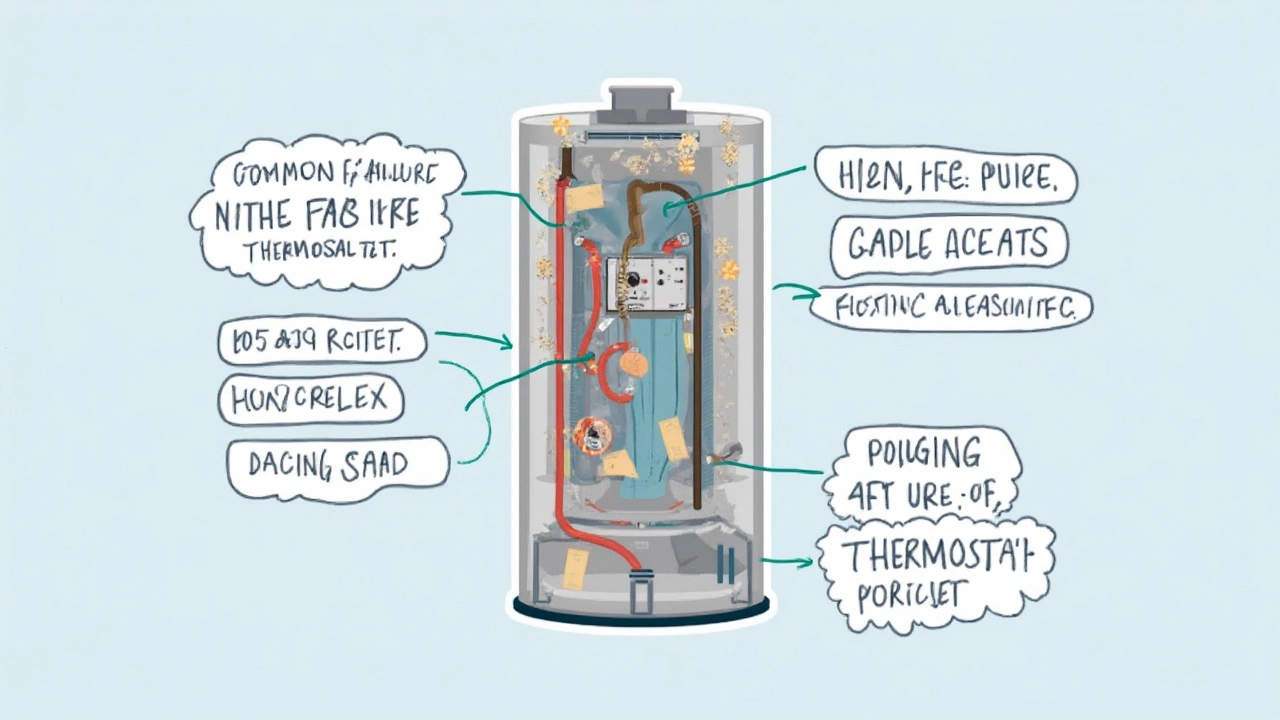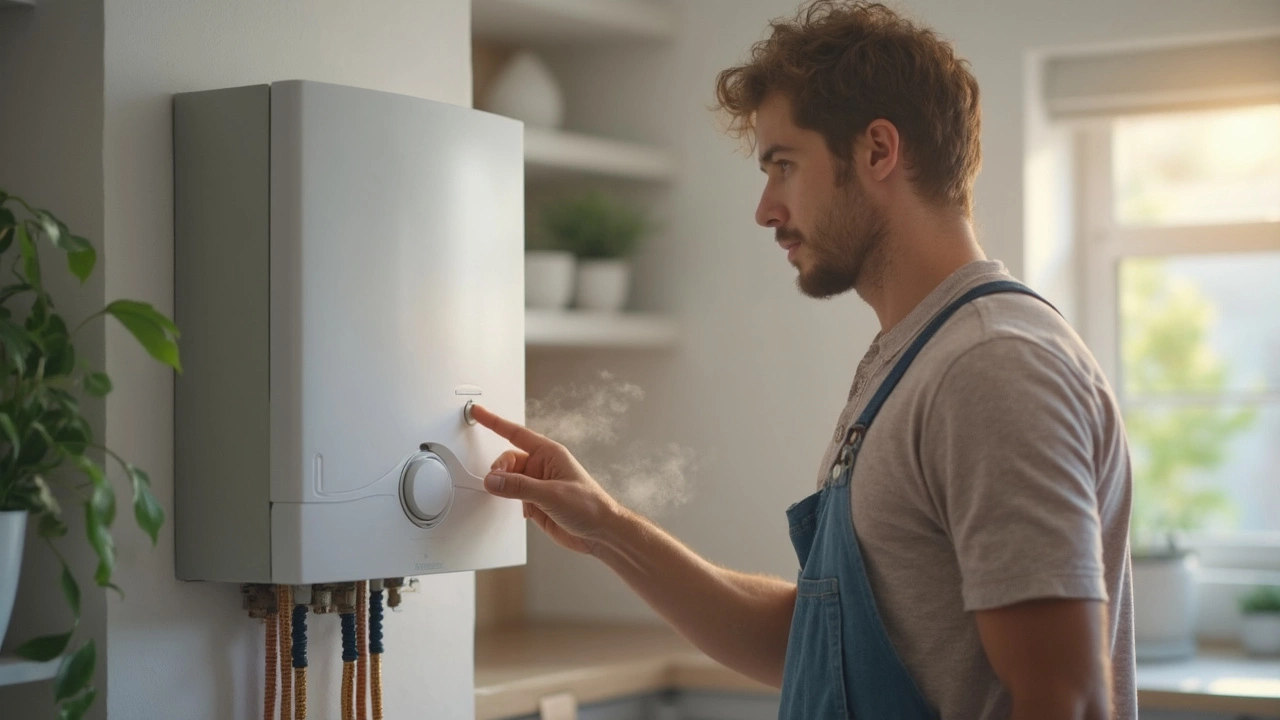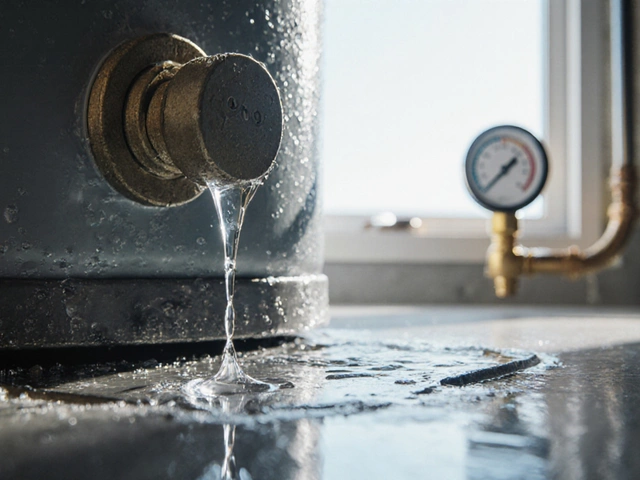Your water heater shouldn't act like a drama queen, shutting off the moment you need it most. If it keeps tripping, whether it’s the circuit breaker or the reset button, something isn’t right—and ignoring it can leave you with cold showers and mounting repair bills.
The good news: most tripping issues come from just a few culprits. Burned-out heating elements, a finicky thermostat, or loose wiring top the list. Sometimes, it’s all about a bit of limescale or a breaker that’s just seen better days. These problems don’t require a toolkit that looks like Batman’s belt; you just need a bit of patience and the right info.
Before you touch anything, safety comes first. Flip off the breaker that controls your water heater. If your unit’s gas-powered, shut off the gas, too. You’d be surprised how many people skip this step and end up with a nasty shock—or worse. With the power off, you can dig in without worrying about dangerous surprises.
- What Causes Water Heaters to Trip?
- Quick Checks Before Calling the Pros
- Common DIY Fixes You Can Try
- When Is It Time to Replace Your Water Heater?
What Causes Water Heaters to Trip?
Let’s get straight to it: when your water heater keeps shutting off, it’s usually screaming for attention. Tripping happens because something’s not working right—and almost always, it’s electrical. The most common triggers boil down to a handful of problems.
- Heating Element Burnout: The heating elements work hard to keep your water hot. Over time, they can crack or short out, causing the electricity to flow where it shouldn’t—like directly to the tank. When this happens, your breaker trips to stop a potential fire. If your water’s lukewarm or you hear popping, this could be the culprit.
- Thermostat Malfunction: That little thermostat is the boss—it tells your heater when to turn on and off. If it fails, it can send the heater into overdrive, overheating the water and tripping safety switches. Some thermostats just wear out after years of use; others get stuck because of limescale buildup.
- Loose or Damaged Wiring: Wires loosen up over the years, especially in older homes. If the connections at the breaker, thermostat, or heating element aren’t tight, you get heat buildup or straight-up electrical shorts. A burning smell near your heater? Pay attention—it’s usually wiring.
- Water Leaks: Water and electricity are a terrible combo. If your tank or the heating elements leak, moisture can mess with electrical parts and trip your system fast. Dampness around the base or rust lines are big red flags.
- Breaker Issues: Sometimes the problem isn’t even in the heater. Breakers wear out just like anything else, especially if they’ve tripped a lot. A weak breaker can pop even when nothing’s actually wrong with your heater.
Check out this table to see how common each problem actually is, based on service calls in the U.S. from 2023:
| Cause | Percent of Cases |
|---|---|
| Burned Heating Element | 38% |
| Thermostat Failure | 26% |
| Wiring Problems | 19% |
| Water Leak | 11% |
| Breaker Fault | 6% |
Notice how most of these issues are electrical? That’s why it’s so important to shut off power first when you start poking around. Taking a few minutes to check the right spots can save you from turning a small fix into a major headache.
Quick Checks Before Calling the Pros
You don’t always need to shell out for a service call right off the bat. There are a few things you can check on your water heater that might save you time and money. Grab a flashlight and go through these steps first.
- Water heater repair: Start by making sure the breaker on your home’s main panel hasn’t just tripped. If it’s off, flip it back on. Sometimes, the breaker gets weak or worn out from years of use. A breaker that won’t reset or keeps tripping usually points to a problem with the heater itself, not just the panel.
- Reset the high-limit switch, also called the ECO (energy cut-off) switch. For electric water heaters, pull off the top access panel and press the red reset button you’ll see on the thermostat. Sometimes, all it takes is this reset to get hot water again—but if it trips quickly after, you’re dealing with something more serious.
- Check for visible leaks around the tank and at the piping connections. Water and electricity never mix. Even a little puddle can lead to electrical shorts that trip the breaker fast.
- Sniff for burning smells or look for scorch marks around the thermostat, heating element, and wiring. Burn marks or melting plastic mean there’s a real risk of electrical fire. If you see or smell anything weird, stop and call a pro.
- Look at the temperature setting. It should be set around 120°F (49°C). Anything higher pushes the thermostat and elements too hard, and can cause constant tripping.
If you want the hard facts, a study by the U.S. Department of Energy found that almost 20% of residential water heater failures were caused by electrical issues, with loose wiring and bad thermostats being the main culprits. Simple checks stop you from going down the wrong troubleshooting path.
| Quick Check | What to Look For | Action Needed |
|---|---|---|
| Breaker Tripped | Breaker won’t reset | Check heater, may need pro |
| Reset Button | Pops out again after reset | Thermostat or element issue |
| Leaks | Any water near unit | Turn off power, address leak |
| Burn Marks/Smell | Plastic or wire damage | Unplug/turn off, call pro |
| Temp Setting | Above 120°F (49°C) | Lower to safe range |
If you’ve checked all these and something still seems off, the problem’s probably deeper inside the unit. But you just ruled out a lot of easy fixes, and you’ll sound like you know your stuff when you do call for help.

Common DIY Fixes You Can Try
Before you ring up a plumber, there are a few things you can check or fix yourself. Most of these don’t need special tools—just a screwdriver, your eyes, and a bit of patience. Since the most common problems involve the water heater repair basics, you’ll want to run through this checklist first.
- Check the reset button: Some electric water heaters have a safety button (usually red) behind a small panel. Press it firmly. If your hot water comes back, the problem isn’t major, but keep an eye on it—multiple resets mean there’s something deeper going on.
- Inspect the thermostat: Setting your thermostat too high (above 120°F or 49°C) can cause tripping. Dial it back and see if that helps. Most models have two thermostats—one on top and one on the bottom—so make sure both are in a reasonable range. Adjust with a flathead screwdriver.
- Look at the heating elements: Bad or burnt-out elements often cause tripping. Turn off the power, take off the cover panels, and you might see visible rust or even hear sizzling. If you have a multimeter, test for continuity—no continuity means the element is shot.
- Tighten up loose wires: Sometimes, the culprit is a loose wire at the breaker, thermostat, or element terminals. Double-check all connections (with the power OFF, of course). Snug connections = fewer problems.
- Clear out sediment: Built-up limescale or debris can insulate the heating element, causing it to overheat and trip. Drain a few gallons from the bottom of the tank into a bucket to flush out some gunk. If the water runs cloudy, keep draining until it’s mostly clear.
Before you go wild with repairs, it helps to know which issues are common. Here’s a quick peek at what typically causes water heater tripping by frequency, based on service calls from 2023:
| Problem | Estimated Frequency (%) |
|---|---|
| Burned heating element | 38 |
| Faulty thermostat | 27 |
| Electrical connection issues | 21 |
| Sediment build-up | 10 |
| Other/misc | 4 |
If you run through these fixes and your water heater’s still tripping, it might be time to bring in the pros. But checking these things first can save you some cash and maybe even fix the problem on the spot.
When Is It Time to Replace Your Water Heater?
Not every issue can be fixed with a quick reset or new part. Sometimes, your water heater has just hit the end of its run. How do you know if it’s time to stop repairing and finally bite the bullet on a new unit? It’s not about guesswork—look for these clear signs.
- Age: If your water heater is over 10 years old (for a tank model), it’s living on borrowed time. Even if it runs, efficiency drops and repairs add up. Tankless models last a bit longer, usually up to 20 years with good maintenance.
- Rusty or discolored water: Brown or reddish tap water means your tank could be corroding from the inside, and it’s only a matter of time before a leak shows up.
- Puddles beneath the tank: Leaky tanks aren’t fixable. If you spot water on the floor or the bottom is constantly damp, a full replacement is your only real option.
- Constant tripping: If you’ve replaced thermostats, elements, and even had an electrician check things out, but your water heater repair jobs just aren’t working, the issue could be a total breakdown in the unit’s wiring or tank.
- Strange noises: Clanking, banging, or high-pitched whining that sticks around after flushing the tank is a red flag. That hard mineral build-up can destroy your heater from the inside.
Check this quick breakdown of average lifespans and the repair price tags that usually signal it’s time to upgrade:
| Heater Type | Average Lifespan (years) | Major Repair Cost ($) | Replace at This Age/Cost? |
|---|---|---|---|
| Tank (Gas/Electric) | 8-12 | 400+ | Yes |
| Tankless | 15-20 | 600+ | Yes |
If repairs start costing more than half the price of a new heater—usually $600 to $1,200 for a tank and up to $3,000 for tankless—it’s almost always smarter to replace. Plus, a new water heater will knock a chunk off your energy bills, especially if your old one is running 24/7 just to keep up.




